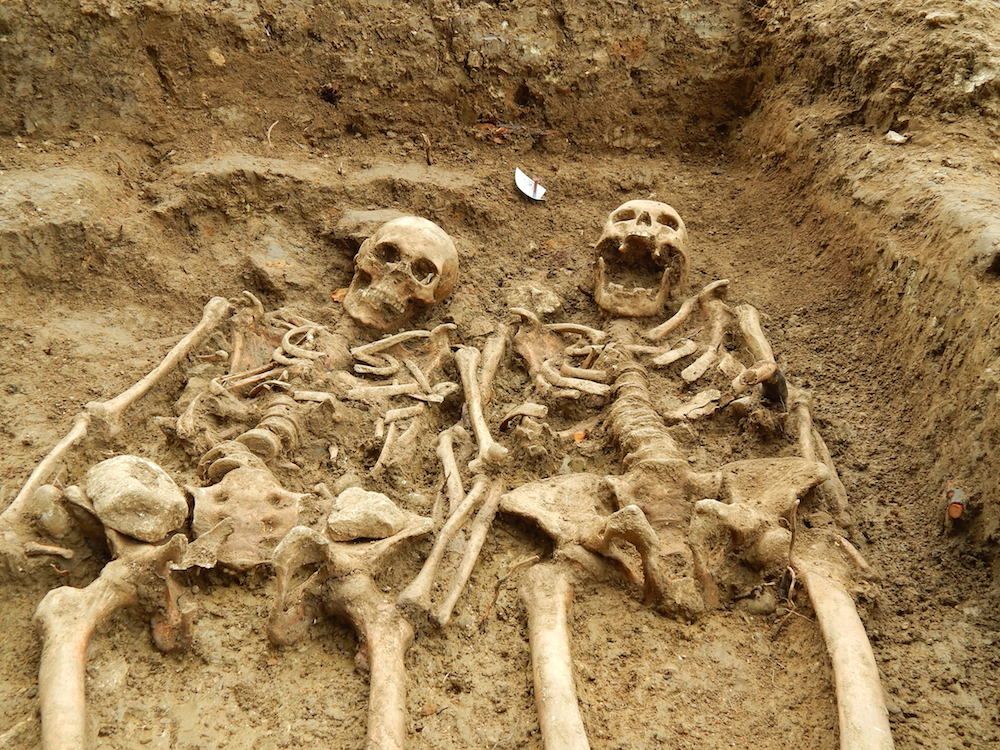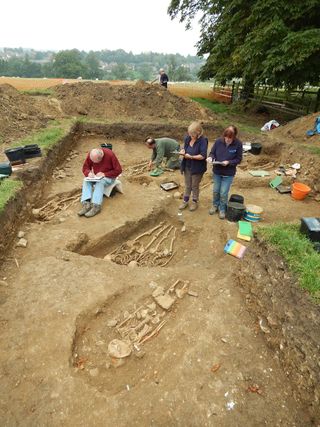700-Year Embrace: Skeleton Couple Still Holding Hands

The skeletal remains of two lovebirds were uncovered, after being locked in a romantic embrace for the past 700 years.
Archeologists found the happy couple holding hands in an earthen grave during an excavation of a "lost" chapel in Leicestershire, England, researchers reported Thursday (Sept. 18).
"We have seen similar skeletons before from Leicester where a couple has been buried together in a single grave," Vicki Score, University of Leicester Archaeological Services (ULAS) project manager, said in a statement.
Double graves are not that unusual. But it's surprising that the two bodies were buried at the so-called "lost" chapel of St Morrell, only recently discovered by a local historian and a team of researchers, instead of at the local church. [8 Grisly Archaeological Discoveries]
"The main question we find ourselves asking is why were they buried up there? There is a perfectly good church in Hallaton," Score said. "This leads us to wonder if the chapel could have served as some sort of special place of burial at the time."
For example, the site may have served as a place of pilgrimage in Hallaton, a village in east Leicestershire, during the 14th century, the researchers said. Or, the couple may have been buried at the Chapel of St Morrell, and not in the main church, because they were criminals, foreigners or diseased.

ULAS archaeologists and local volunteers have spent the past four years uncovering the lost chapel of St Morrell, near the village of Hallaton. The team has found evidence that the use of the hillside extends back to Roman times, more than 2,000 years ago.
Sign up for the Live Science daily newsletter now
Get the world’s most fascinating discoveries delivered straight to your inbox.
For instance, a square ditch at the site indicates that the hilltop may have once held a Roman temple. The team also found an Iron Age shrine with thousands of coins and silver artifacts, such as a Roman cavalry helmet.
Excavations now show the chapel's walls and tiled floor, along with pieces of stone masonry, wall plaster, tiles, lead from the windows and a nearby cemetery. Archaeologists have also found money among the ruins, including several silver pennies. These coins, which date back to between the 12th and 16th centuries, have helped researchers determine the chapel's most active years.
Through the process of radiocarbon dating, the archaeologists determined that 11 skeletons so far excavated from the site date back to the 14th century. All of the skeletons found at the chapel site were laid in an east-west orientation, per Christian tradition at that time.
Follow Laura Geggel on Twitter @LauraGeggel and Google+. Follow Live Science @livescience, Facebook & Google+. Original article on Live Science.

Laura is the archaeology and Life's Little Mysteries editor at Live Science. She also reports on general science, including paleontology. Her work has appeared in The New York Times, Scholastic, Popular Science and Spectrum, a site on autism research. She has won multiple awards from the Society of Professional Journalists and the Washington Newspaper Publishers Association for her reporting at a weekly newspaper near Seattle. Laura holds a bachelor's degree in English literature and psychology from Washington University in St. Louis and a master's degree in science writing from NYU.









